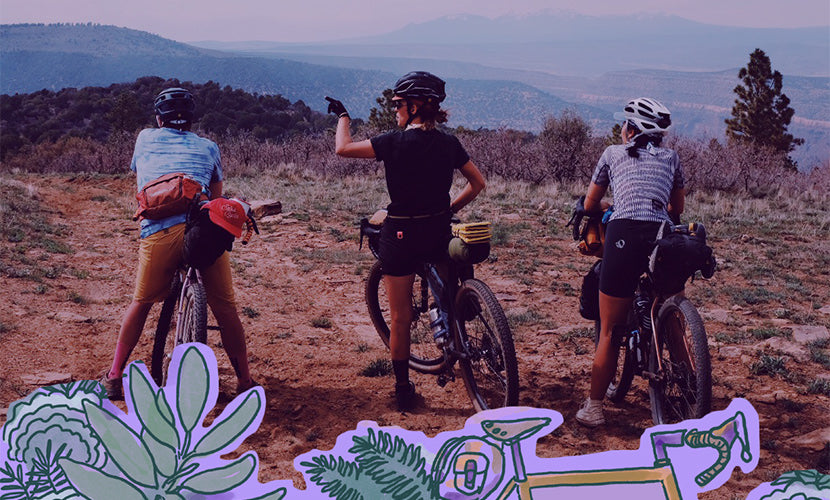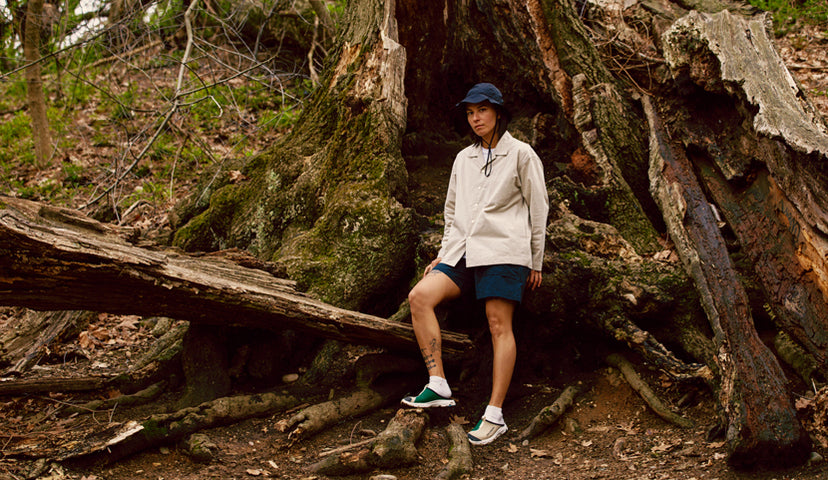This week, Martina Brimmer, co-founder of Swift Industries, shared her tips and tricks for new bike campers. If you're dreaming of remote trails, epic views, and backcountry adventures, read on for everything needed to get you started.

Pick your gear
As with any outdoor excursion, the proper gear is key! Martina recommends packing a shelter (a tent, tarp, or hammock), a ground pad, and a sleeping bag.
Equally as important to your shelter and sleep setup is your kitchen kit. We've added a few of our own recommendations to her list!
- Cutting board out of food-grade plastic
- Knife - try the Field Knife with its included sheath.
- Spork – as Snow Peakers know, nothing beats the Titanium Spork!
- Spice kit (small containers of salt, pepper, cumin, chili, honey, etc.)
- Small plastic bottle of cooking oil
- Pot and pan – the Trek 900 is the perfect solution!
- Backpacking stove and fuel – try the GigaPower Stove Auto and GigaPower isobutane.
- Coffee kit – add the Collapsible Coffee Drip and some filters to your pack, and you're all set!
- Mug for both eating and drinking – use the Ti-Single 450 Cup for any beverage or mug meal.
Pack up
Lightweight adventurers know the importance of creative packing. Waste no space! Martina says pre-packing strategizing is key.
"Think of your empty spaces first. Use the soft stuff like socks, leggings, and your puffy jacket to fill in the area around hard goods, like mortar between bricks. Put your fuel canister in an empty cook pot, then utilize the rest of that dead space with something soft, like socks or your kitchen rag. A tent can be attached to the top of the rear rack to leave space inside your touring bags for weather-sensitive provisions. A little mindfulness goes a long way: put sensitive gear like down sleeping bags and electronics in seam-sealed bags."
She recommends packing your gear in the order of use. Group your items needed for the evening together, and leave your gear for the day in an easy-to-reach section. Lastly, shrink items as much as you can! Consider each piece of gear and whittle down non-essentials.

Plan your route and be prepared
Avoid getting lost with proper pre-trip planning! Martina suggests starting with an old-fashioned paper map, then cross-referencing with Google Maps for cycling to your destination.
"Start by plugging in your destination and toggling to bicycle mode in Google Maps, then fine-tune the suggested route. Quiet roads are sure to impress, so when you're planning, maximize those digital maps to reveal the backroads that every traveler longs for. Try roads with old in the title. "Old Woodinville-Duvall Road" has likely been replaced by a larger, more heavily trafficked thoroughfare, leaving the grandparent highway underused and laid back (though sometimes also a little more rolling)."
Local knowledge is top-notch but be wary of tips from folks who have only driven the stretch of road. Another important factor to consider is your daily mileage. Martina recommends 45-50 miles per day, but less is fine too! Weather, road conditions, and other factors will have an impact.
"Keep in mind that 50 miles of flat roads with a heavenly tailwind are very different than 50 dirt miles over mountain passes. Sometimes a day's distance is predetermined by the distance between your chosen campgrounds, and you may have to pull a long day in the saddle to make it into camp."
Play in nature
Last but certainly not least, embrace all that the backroads have to offer. Take a swim in a river or lake, pause to listen to the birds or watch the wildlife, wake up early to watch the sunrise. These are the magical moments that get us out there. Reconnect with the rhythms of nature, wherever the road takes you.
Martina says, "It's all about tuning in and dropping out. Start paying attention to where you are in the moment and walk away from the daily grind to get perspective and reorient yourself. The magic of bike-camping is that it's equal parts going there and getting there."
For more helpful bike camping tips, check out Swift's blog or RSVP for one of the activations taking place during the Swift Residency at Snow Peak Portland.


